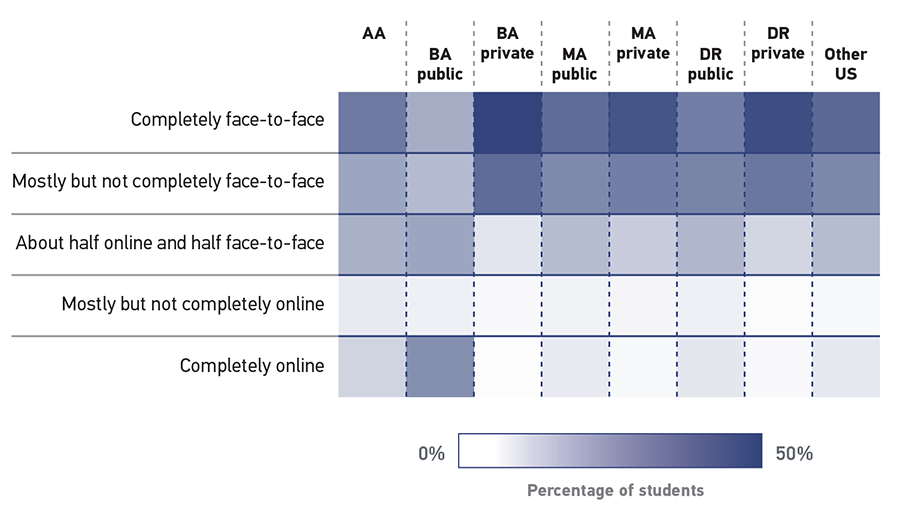Learning Environment Preferences
What's the difference between students who prefer their courses to "have no online components" and students who prefer their courses to "be completely face-to-face"? Apparently, quite a bit. In 2018 we changed how we asked students about their learning environment preferences1 and got starkly different answers. We had observed in recent years a steady decline in the percentage of students who prefer their courses to have no online components, but our results this year revealed a significant spike in the number of students who prefer completely face-to-face courses—38%, compared with the 9% in 2017 who said they prefer no online components. Although the added precision to the question presents us with more accurate but unexpected results, the general thrust of our findings from previous years—that the majority of students (55%) prefer some form of blended learning environment over either purely face-to-face or online versions—continues to hold (see figure 5).

So what is driving students' inclinations? It seems that it's similar to what influences human preferences in other contexts as well: exposure and experience. Long-standing research has shown us that "mere exposure"2 builds familiarity, which can lead to our preferences for everything from foods to sounds to faces. Our data from the past few years have suggested that students prefer learning environments where they have had recent experiences, and the same correlation is holding for 2018. When we controlled for a host of factors,3 the most significant predictor for learning environment preference was recent experience (over the past 12 months). Student preferences are also polarizing: Those who have never taken a completely online class are significantly more likely to prefer face-to-face-only courses, and vice versa. However, students who have taken at least some of their courses online are significantly more likely to prefer blended environments and less likely to prefer purely face-to-face courses.
These results make sense when we consider the science of exposure. It seems reasonable that students would like environments where they have had their most recent (and perhaps positive) experiences, since these are the most familiar. By the same token, students who are just starting their college careers and have never taken an online course may be hesitant to dive into an environment with a heavy digital format, especially if they are making the leap from high school or the workforce to college. Lack of confidence or concerns about how successful they may be—or have been in the past—in online courses may also influence their preferences. If students are to become more acclimated to blended learning environments, they should be exposed to courses with online components early in their college careers. Experiences in these settings can help them prepare for the demands of the 21st-century workforce, where blended and telecommuting work environments have grown exponentially.4
Educating students about the benefits, expectations, and demands of different learning environments is also critical to helping them make informed decisions about the environments that work best for them. IT can partner with other campus units to reach students via multiple sources to consistently share clear communications and resources about the differences between face-to-face, blended, and online courses. Collaboration opportunities exist at new-student orientations, during advisement and registration, at academic support centers, and in disciplinary departments, teaching and learning centers, and disability service offices. Faculty who lack experience teaching blended and/or online courses should also be exposed to professional development, training opportunities, IT campus resources, instructional designers, and teaching and learning centers.
Notes
-
Between 2017 and 2018, we continued to ask the same question: "In what type of learning environment do you most prefer to learn?" In 2017, the response options included the following: "One with no online components," "One with some online components," "About half online and half face-to-face," "One that is mostly but not completely online," "One that is completely online," and "No preference." In 2018, we changed the response options to the following: "One that is completely face-to-face," "One that is mostly but not completely face-to-face," "About half online and half face-to-face," "One that is mostly but not completely online," "One that is completely online," and "No preference."
↩︎ -
Robert B. Zajonc, "Attitudinal Effects of Mere Exposure," Journal of Personality and Social Psychology 9, no. 2 (pt.2, 1968): 1–27, DOI:10.1037/h0025848.
↩︎ -
These included variables such as Carnegie class, FTE, gender, ethnicity, Pell Grant eligibility, full-time/part-time enrollment status, and first-generation college status.
↩︎ -
"2017 State of Telecommuting in the U.S. Employee Workforce." Global Workplace Analytics & FlexJobs.
↩︎